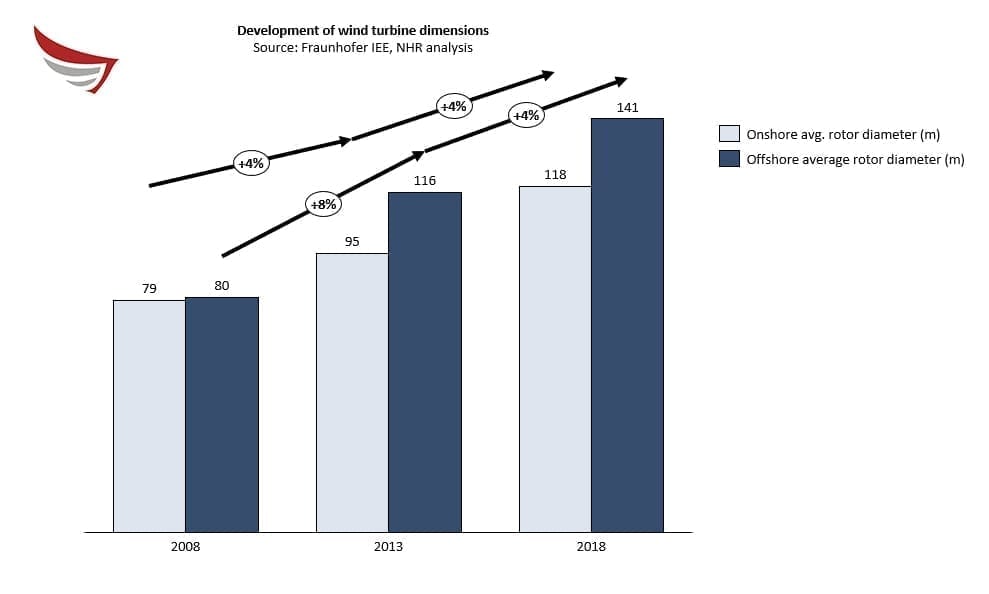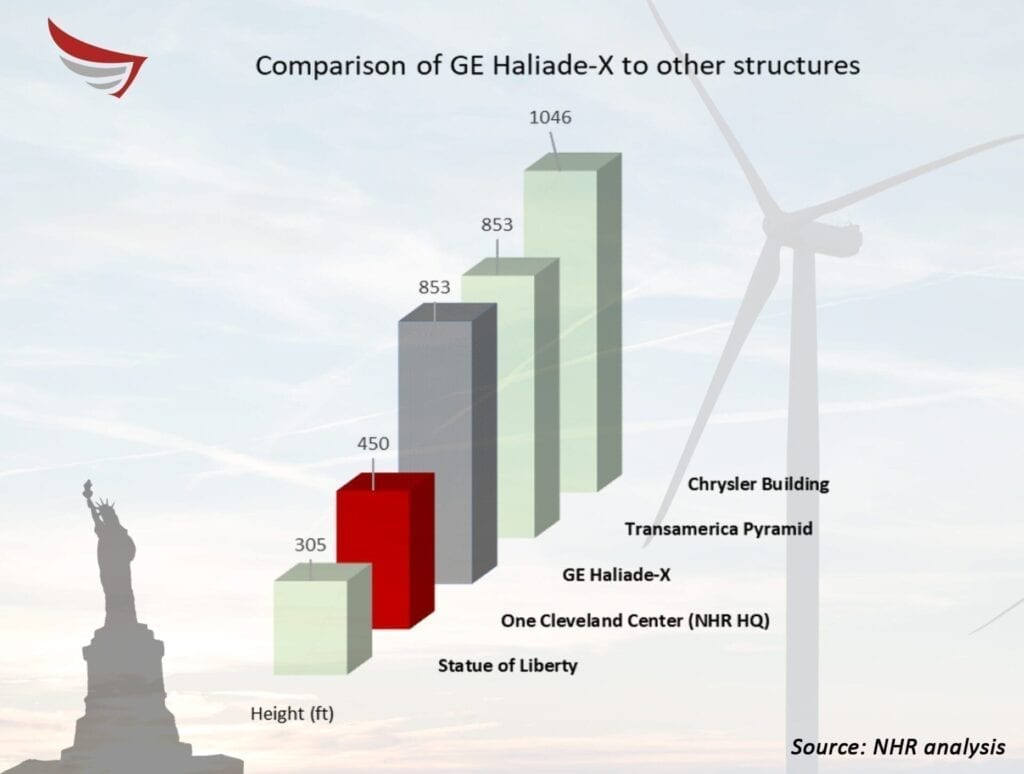What we did:
In January and February 2020, NHR researched the wind energy technology industry. We spoke with scientific researchers and government energy policy representatives in the USA, UK, and Europe, and with renewable energy facility owner-operators, support teams, and consultants in the US.
What we found:
Wind blades are getting bigger. Much bigger.
The wind energy industry is under pressure to produce more electricity for lower operational cost. Part of this pressure is due to internal margins shrinking and government incentives for capital investments beginning to wane. Additionally, the National Renewable Energy Laboratory (NREL) notes that the wind energy industry is under competitive stress from the expansion of solar power and from lower costs for natural gas. The squeeze from solar and natural gas has contributed to a slowdown in the expansion rate of wind energy, while underscoring the need for greater technological efficiency. For wind turbines, achieving “efficiency” often means larger turbines with greater energy capture and output potential.

Bigger really does mean better when it comes to power output.
The physical size of wind turbines, including towers and rotors (blades) has increased by over 50% in the last 2 decades. The blade radius of an average offshore wind turbine was 141 meters in 2018. That is over the length of one-and-a-half football fields, sometimes rotating at speeds over 200MPH at the blade tip.
As a matter of electrical output, larger blades gather more wind potential, spin more quickly, and can power higher-output wind turbines. Taller towers “make it possible to cost-effectively tap the stronger wind resources that exist at higher [altitudes], beyond the reach of today’s typical turbines and above interference from trees, buildings, and landscape or topographical features.” (Wind Energy Technologies Office, 2019).
A current example of this trend is GE Renewable Energy’s Haliade-X, an offshore turbine standing at 853ft—the same height as San Francisco’s Transamerica Pyramid.

To put this into perspective, New Heights Research is in One Cleveland Center, in Downtown Cleveland, Ohio. One Cleveland Center is a 30-story building and is only about 53% the height of the Haliade-X!
The bigger they come, the harder it is to take care of them.
Wind blades are generally rated to last 20-25 years. However, the impact forces upon the blades from rain and ice strikes are multiplied by the blades’ enormous mass and velocity. This can result in destructive erosion of the blades’ leading edges and considerable damage. “You will have holes in the leading edges,” commented one expert to New Heights.” You can actually fit your fist in them! We are not talking little nibbles. We’re talking about significant chunks of the blade.” This damage can lead to loss of all-important efficiency, up to 5% of turbine output. That’s even before structural weakness begins to set in.
Up to today, blades were cared for by sending technicians down the blade edge by rope to patch damaged spots with resins and specialized paints. However, the new blade heights and their associated dangers make this method increasingly unsafe and unworkable. This is particularly true in offshore wind energy, where technicians may be performing repairs from dizzying heights while suspended over the ocean. Importantly, these efforts are focused on repair, rather than proactive protection of the infrastructure. And as blades continue to grow in length and speed, impact forces will continue to multiply.
New solutions to blade protection are likely to find traction.
There are two newer types of approaches to wind blade care: data-driven solutions, and physical erosion barriers.
Data solutions use video observations by drones and telemetry from the turbines to focus the efforts of repair crews. The goal is to reduce their exposure to danger while addressing damage before it becomes severe. However, this solution remains reactive and do not take steps to prevent damage.
Physical solutions include protective paints, polymer tapes, and rigid shields. One expert New Heights spoke to described gelcoats as a “sacrificial coating,” only effective for the first 3-5 years of a blade’s life. While tapes appear promising, there is limited feedback in the US market on their longevity. UK experts interviewed by New Heights felt they also tended to lose efficacy after about 3 years. Shields may offer greater protection, but their longevity is also a matter of debate. “What the wind farm operators really want,” commented an expert, “is not to have to touch the blades for 25 years.”
Opportunities are opening in the space for wind infrastructure erosion protection.
The gap in effectiveness continues to grow between existing protection solutions and increasingly large wind turbines. New generations of solutions may offer attractive investments for those who know how to identify ones that offer value to the industry.
If you have questions on trends and opportunities in renewable energy, please contact us. Please follow us on Twitter and LinkedIn to stay up to date.
